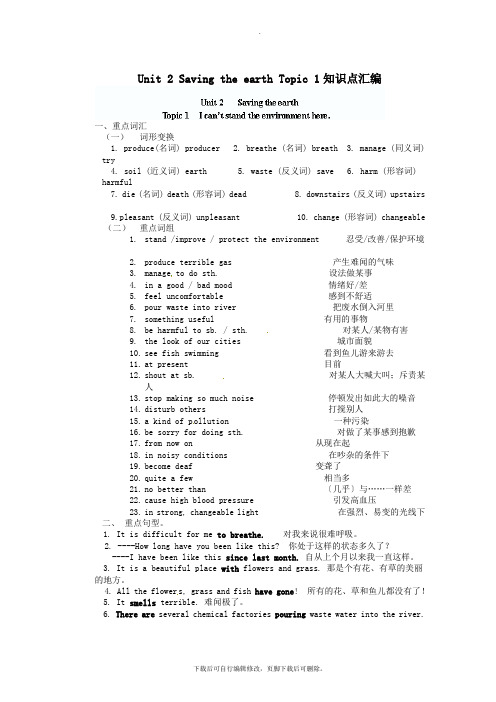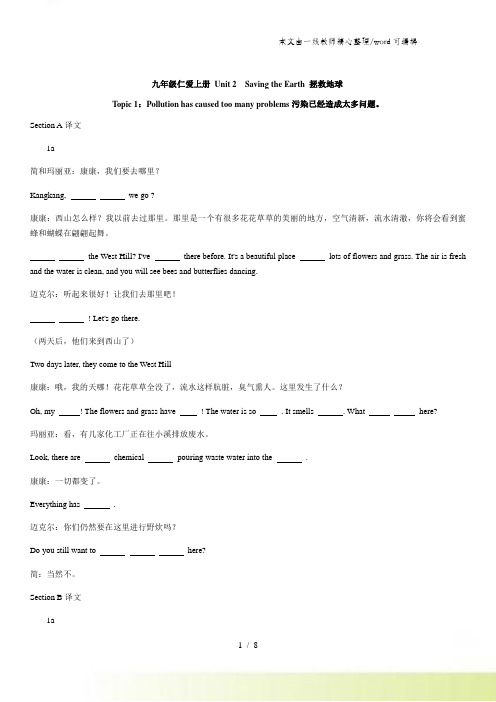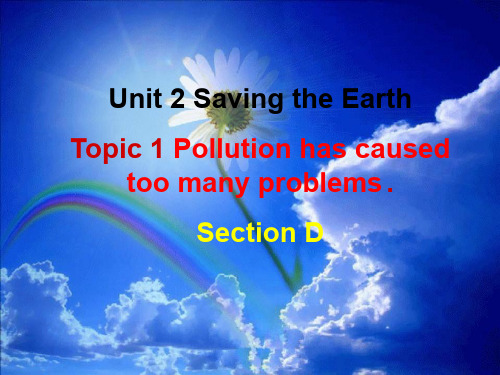仁爱版九年级英语上册Unit 2 Saving the Earth Topic 3 Section A 教案
- 格式:doc
- 大小:102.00 KB
- 文档页数:15

Unit 2 Saving the earth Topic 1知识点汇编一、重点词汇(一)词形变换1. produce(名词) producer2. breathe (名词) breath3. manage (同义词) try4. soil (近义词) earth5. waste (反义词) save6. harm (形容词) harmful7. die (名词) death (形容词) dead 8. downstairs (反义词) upstairs9.pleasant (反义词) unpleasant 10. change (形容词) changeable(二)重点词组1.stand /improve / protect the environment 忍受/改善/保护环境2.produce terrible gas 产生难闻的气味3.manage to do sth. 设法做某事4.in a good / bad mood 情绪好/差5.feel uncomfortable 感到不舒适6.pour waste into river 把废水倒入河里7.something useful 有用的事物8.be harmful to sb. / sth. 对某人/某物有害9.the look of our cities 城市面貌10.see fish swimming 看到鱼儿游来游去11.at present 目前12.shout at sb. 对某人大喊大叫;斥责某人13.stop making so much noise 停顿发出如此大的噪音14.disturb others 打搅别人15.a kind of p ollution 一种污染16.be sorry for doing sth. 对做了某事感到抱歉17.from now on 从现在起18.in noisy conditions 在吵杂的条件下19.become deaf 变聋了20.quite a few 相当多21.no better than 〔几乎〕与……一样差22.cause high blood pressure 引发高血压23.in strong, changeable light 在强烈、易变的光线下二、重点句型。

九年级仁爱上册Unit 2 Saving the Earth 拯救地球Topic 1:Pollution has caused too many problems污染已经造成太多问题。
Section A译文1a简和玛丽亚:康康,我们要去哪里?Kangkang, we go ?康康:西山怎么样?我以前去过那里。
那里是一个有很多花花草草的美丽的地方,空气清新,流水清澈,你将会看到蜜蜂和蝴蝶在翩翩起舞。
the West Hill? I've there before. It's a beautiful place lots of flowers and grass. The air is fresh and the water is clean, and you will see bees and butterflies dancing.迈克尔:听起来很好!让我们去那里吧!! Let's go there.(两天后,他们来到西山了)Two days later, they come to the West Hill康康:哦,我的天哪!花花草草全没了,流水这样肮脏,臭气熏人。
这里发生了什么?Oh, my ! The flowers and grass have ! The water is so . It smells . What here?玛丽亚:看,有几家化工厂正在往小溪排放废水。
Look, there are chemical pouring waste water into the .康康:一切都变了。
Everything has .迈克尔:你们仍然要在这里进行野炊吗?Do you still want to here?简:当然不。
Section B译文1a(一个老太太正在咳嗽,她看起来虚弱)An old lady is coughing. She looks .康康:早上好,老奶奶。

仁爱版九年级英语上Unit 2 Saving the Earth Topic 1 Pollution has caused toomany problems海南华侨中学初中部英语组吴小武一、教学课题:Topic 1 Pollution has caused too many problems二、教学内容:1. Master some new words and useful expressions:Produce, chest, breathe, manage, waste, cancer, influence, look, several, secretary, relation, fisherman, president, dead, rabbit2. Direct speech and indirect speech3. Learn something about some kinds of pollution:(1)The large population has caused many problems.(2)Air pollution makes people sick.(3)Light pollution is harmful to our eyes.(4)Litter influences the look of our cities.4. Let students know that pollution is really a serious problem.5. Talk about the environment in the past, at present, and how to protect the environment.6. Let the students know something about the noise pollution in order to make life comfortable and pleasant.三、教学目标:1. Direct speech and indirect speech2. Learn how to express complaint.3. Realize the harm of water pollution and enhance the students’ awareness of the importance of protecting the water resources.4. Realize the harm of noise pollution.四、教学重点:1. Direct speech and indirect speech2. Learn how to express complaint.3. Realize the harm of water pollution and enhance the students’ awareness of the importance of protecting the water resources五、教学难点:1. Learn the present perfect tense with since.2. Learn how to express complaint.3. Learn the present perfect tense with for.六、教学准备:课前让学生准备一些有关各种污染的一些图片。

1 / 18Unit 2 Saving the Earth 教案Topic 2 All these problems are very seriousSection CⅠ. Material analysis本课是第二单元第二话题的第三课时,主活动是1a 和3。
通过阅读1a ,进一步学习各种污染对地球造成的危害和造成这些污染的原因,培养学生通过图片预测文章大意的能力,其中出现了很多关于环境的专业术语,需要学生了解。
1b 是训练学生运用不同的阅读策略完成不同的任务,如:通过观察1a 中的图片匹配相应的标题,再阅读文章,给每段话选择标题;另外,继续训练学生通过语境,找出单词指代的内容;最后在理解课文的前提下,归纳文章的大意。
1c 培养学生通过精读文章,学会用简单的词句做笔记,再通过1c 表格中的内容简要复述文章大意。
2是培养学生的资源策略。
要求学生合理地运用网络资源查找与环境危害相关的信息,然后进行小组讨论,并要求学生做好笔记,为任务3做准备。
3要求学生运用这些信息,在1c 和2的基础之上进行写作练习,教师应强调衔接词在作文中的重要性。
由于课堂上不方便完成2,因此,可将2和3安排为课后作业。
通过读写的结合训练,引导学生关注全球环境的现状,意识到环境保护的重要性,树立正确的环保观念。
Ⅱ.Teaching aims 1.Knowledge aims :掌握本课的重点词汇和短语,初步感知定语从句。
进一步学习各种污染对地球造成的危害和造成这些污染的原因。
2.Skill aims:能读懂有关环境问题的文章。
能根据不同的阅读目的,运用简单的阅读策略获取信息。
能正确运用网络资源获取需要的信息。
能用英语书面的形式表达环境问题的成因及危害。
3.Emotional aims: (optional)通过学习,了解环境现状,帮助学生树立绿色环保意识。
4.Culture awareness: (optional)了解各种环境问题,如臭氧空洞,温室效应等,意识到环境问题的严峻形势。


1 / 13Unit 2 Saving the Earth 教案Topic 2 All these problems are very seriousSection DⅠ. Material analysis本课是第二单元第二话题的第四课时,是本话题的复习课,主活动是1a 和Project 。
通过Grammar 和Functions 让学生归纳总结本话题的语法知识——不定代词和不定副词的用法,以及一些重要的表达。
通过1a 部分,培养学生寻找段落之间的逻辑关系,再利用逻辑关系完成排序任务。
1b 引导学生在阅读过程中注意“wh-questions”,提高阅读效率。
2是通过小组讨论的方式,探究保护水资源和和节约用水的方法,为3的写作任务作铺垫。
3是教会学生如何写倡议书,培养学生在写作中排篇布局,即先构建写作框架,再加上合理的观点。
Project 是通过让学生换位思考,充当不同的自然资源,描述各自的功能,现状和期望,来唤起大众保护环境的意识。
本课所设置的“写倡议书”和“制作海报”都在培养学生“用英语做事情”的能力。
Ⅱ. Teaching aims 1.Knowledge aims :掌握本课的重点词汇和短语,复习不定代词,不定副词和重点表达法。
了解淡水资源短缺的现状。
2.Skill aims:培养学生通过wh-questions(如:what,why等),理解短文的意思。
能够读懂有关自然资源的文章。
能够利用已有框架,加上自己的观点,提高写作技能。
3.Emotional aims: (optional)关注自然资源的现状,倡导学生保护环境,节约用水。
4.Culture awareness:(optional)通过对水资源现状的了解,认识到自然资源对人类的重要性,加入到保护环境、珍惜资源的队伍中。
Ⅲ. The key points and difficult points1. Key points:Words and phrases: avoid, discover, thirsty, nearly, law, shortage, resource, reuse,take sth. away from…, the shortage of water / water shortage, avoid (doing) sth., make progress in, nearly 3/4 of…2. Difficult points:学会归纳话题中的重点语法和表达法。
1 / 12Unit 2 Saving the Earth 教案Topic 1 Pollution has caused too many problems.Section DⅠ. Material analysis本课是第二单元第一话题的第四课时,主活动是1a 和Project 。
通过Grammar 来巩固总结一般过去时和现在完成时的区别,通过 Functions 来复习重要的表达法。
1a 按照“总—分—总”的模式分别介绍了各种污染的成因及危害。
通过完成文章后的表格,训练和提高学生获取信息的能力。
教师还可以利用表格内容,引导学生整合信息复述课文,巩固课文内容。
1b 属于同义转换练习。
Project 部分培养学生动手动脑的能力,让学生运用收集的信息和所学知识,通过墙报的形式来宣传污染带来的危害,让更多的人关注环境污染,树立环保意识,增强人们的忧患意识和社会责任感。
Ⅱ.Teaching aims 1.Knowledge aims :掌握本课的重点词汇和短语。
总结一般过去时和现在完成时的区别;复习本话题的重点表达法。
2.Skill aims:能读懂与环境污染问题有关的文章。
能根据关键词复述课文。
3. Emotional aims: (optional)通过了解各种污染带来的危害,帮助学生树立环保意识,爱护环境,保护地球。
4.Culture awareness: (optional)通过学习,引导学生了解环境污染对人类健康有巨大的危害,不同种类的污染体现在不同的方面。
Ⅲ. The key points and difficult points1. Key points:Words and phrases: coal, create, blood, planet, in many ways, with the development of industry, high blood pressure Grammar: the differences between the simple past and present perfect2. Difficult points:能根据关键词复述课文。
仁爱版英语九年级上册Unit2SavingtheEarth仁爱版英语九年级上册Unit 2 Saving the Earth教材分析:本单元的三个话题紧紧围绕环境问题展开。
第一部分Pollution cause too many problem. 由谈论美丽西山的环境变化引出污染这一话题,并融入了功能项目“责备和抱怨”。
本部分的重点语法是直接引语和间接引语。
第二部分All these problems are very serious. 承接第一部分的内容,介绍了污染给人们生活所带来的危害。
不定代词和不定副词的用法是这一部分的语法重点。
第三部分Would you like to be a greener person? 承接了一、二部分的内容,谈论环境保护的问题,并给出建议。
本部分的语法项目是含有or, and, while 和but 的复合句。
本单元学习完毕后要求学生能树立环保意识,并能采取切合实际的行动来保护环境。
Topic2 All these problems are very serious. 本部分是前一个话题的继续,主要谈论环境污染所带来的危害。
通过描述贴近生活的事件,向学生展示环境污染的危害。
本话题的语法项目是不定代词和不定副词的用法。
学生情况分析:定南中学九年级(2)班一共有49名学生,其中26名为女生,23名为男生。
其中英语成绩比较好学生的仅为4—6名,其它的学生英语的基础都比较差。
但是如果是对于较为简单的英语游戏还是有大部分学生能够参与进来。
学生们尝试着在老师的引导之后用自己的能力去猜测和理解对话的主要内容以及对话想要传达的意思。
因为本文的内容较为接近我们的生活,所以有利于学生理解和学习相关的对话以及重点短语、句子。
由于学生的基础比较差,为了帮助学生们更好地学习课文,我利于了课文所带有的图片练习来引导学生们猜测和了解有关沙尘暴的背景知识,并且引出相关的生词,之后再做相关介绍,通过充分的读前活动,则可使学生们在听对话时减少难度。
Unit 2 Saving the Earth 教案
Topic 3 What can we do at home to protect the environment?
Section A
Ⅰ. Material analysis
本课是第二单元第三话题的第一课时。
主活动是1a和2。
1a 通过记者采访Jane,询问有关Jane 在环保组织的活动,引出话题内容:如何做一个环保人士。
通过介绍在生活中如何践行环保行为,自然地用到本话题的功能意念:提出建议。
在提出建议的同时,又引出本话题的语法:并列句。
1b是个难度比较高的听力任务。
它不是单纯地考查听写,而是要求学生在听懂内容的基础上,对材料进行归纳之后再填空。
1c是用第一人称来转述1a的内容,旨在向学生传播环保理念。
2是针对并列句而设计的专项语法训练。
3a和3b是在考查学生的垃圾分类意识之后,再通过听对话来进行验证。
4再次让学生对垃圾进行分类,以此来培养学生对垃圾再利用的环保理念。
通过学习本课,可以增强学生的环保意识。
培养学生在写作时运用连接词写出比较连贯的句子的能力。
Ⅱ. Teaching aims
1.Knowledge aims:
掌握本课的重点词汇和短语,初步学习并列句和提建议。
2.Skill aims:
能够给别人提出合理的建议。
能够正确地运用连接词写出并列句。
能够把所听到的听力材料先归纳再填空。
3.Emotional aims: (optional)
鼓励学生在日常生活中自觉践行环保行为。
4.Culture awareness: (optional)
Ⅲ. The key points and difficult points
1. Key points:
Words and phrases: nod, agreement, disagreement, protection, organization, recycle, can, give up, so that, encourage sb to do sth.be harmful to sb./sth.
Sentences: We should reduce the waste we produce.
We should use both sides of paper and reuse plastic bags.
It’s a pleasu re.
Recycling can protect the environment, and it can save money, too.
So we encourage students to collect waste paper and soft drink cans.
Grammar: compound sentence
2.Difficult points:
根据句子需要,正确地选用连接词。
理解含有定语从句和情态动词被动语态的句子。
Ⅳ. Learning strategies
在1b任务中,要先听懂对话内容,再归纳填空。
在2中,要明白不同的连接词的不同用法。
首先弄清上下句的关系,再确定用哪个连接词。
在3a中,要充分利用自己的生活经验和已有的知识。
Ⅴ. Teaching aids
教学新词的实物(如:胶袋、电池、易拉罐等)/有环保标识的纸盒或瓶子/录音机/小黑板/PPT图片等。
Ⅵ. Teaching procedures
Ⅶ . Blackboard design。